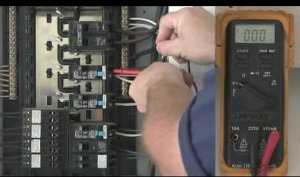
Maybe your breaker trips always and you want to know if the circuit breaker has gone bad!
A breaker can go bad, but not always.
A tripping breaker can be a warning sign of overload, short circuits, wrong wiring, ground faults, or a bad breaker.
You will need to find out what is tripping the safety switch before assuming it has gone bad.
The primary function of a circuit breaker is to shut off the power when there is over current. Each time it detects one, it trips the circuit to prevent electrical hazards.
While the breaker may go bad, always confirm from a licensed electrician before replacing it.
Signs and how to tell if a circuit breaker is bad
Below are the warning signs that a breaker has gone bad. They include:
Burning smell from the breaker box
The burning smell from your electrical panel is a clear sign that something is wrong. Always power off the control switch to the house each time you notice this and call an electrician for troubleshooting.
Circuit breaker hot to touch
A hot breaker may be a sign of overload. Check to see if you are overloading the circuit. If not, call a professional electrician to prevent an electrical accident.
Frequent tripping
If your breaker keeps tripping and you have ruled out overload, short circuit and ground fault as the cause, there might be a problem with your circuit breaker.
Related article: Why your circuit breaker trips even without a load
Visible damage to the outlet
Visible damage, such as burned parts or broken switches, may mean that your breaker is bad.
If you notice such in your house, call a professional for emergency services.
Aged breaker
According to the Consumer Product Safety Commission (CPSC), the lifespan of a circuit breaker is about 30-40 years.
If your breaker has lasted for so many years and is showing faulty symptoms such as flickering, smoke coming out of it, or frequent malfunctioning, change the device.
Tools required to test a circuit breaker to see if it is faulty
To test an electrical circuit protector, you will need the following tools:
- A screwdriver
- Digital multimeter
- Safety gloves
- Wire stripper to strip and dress the wire
- New circuit breaker, in case you want to replace the old one.
How to test a circuit breaker to see if it is bad
Before you conclude that your circuit protector has failed, do these preliminary checks.
Locate the breaker that leads to the room where you are having the problem
- Unplug all the appliances connected to the branch circuit to make sure you did not overload it.
- Check if the switch is still functional.
- Reset the breaker by turning it OFF and ON.
- After resetting, monitor the light to see if it still trips. If it does, continue with the following steps:
Step 1: Unplug all appliances connected to the circuit
As a general rule, you should first unplug all devices on the circuit you want to test
This is to protect your device from power surge which may arise during testing.
Step 2: Remove the breakers panel or cover
After unplugging the device from the circuit, switch off the breaker and lose the screw on the breaker cover.
Handle the whole process with care to avoid damaging the screws or allowing the panel to fall down.
But before embarking on the work, make sure you put on your personal protective equipment such as safety gloves, boots and also make use of insulated tools.
Step3: Test the circuit breaker with a multimeter
You can easily detect a faulty breaker by measuring its voltage using a multimeter.
Depending on the type of breaker you are using, the voltage reading should be around 120 Volts for a single-pole, and 240 V for double pole breakers.
A voltage reading of zero or anything less than 120 V for a single-pole, and 240 for double poles, shows the breaker is bad and should be replaced.
Here is a complete guide on how to change or replace a bad circuit breaker.
You can buy a new circuit breaker here at amazon
FAQ
1. What are the signs of a bad circuit breaker?
Signs of bad circuit breakers include:
- Flickering light: This means a shaking light. Flickering light can damage electrical appliances if you do not contain it in time. It is a sign that something is wrong with your electrical system, which may be the breaker, short circuit, over-current, and others.
- Poor performance from your device: A weak breaker can make your appliances behave as if they have gone bad. For example, your dryer might trip off mid-way.
- Burning smell: A burning smell can arise from faulty wiring, partial contact, or faulty breaker. Always contact a professional electrician for troubleshooting.
- Signs of damage: If some parts of the safety switch are no longer functional, for example, a faulty switch, you will need to change it.
- If it trips continuously.
2. Can a circuit breaker go bad without tripping?
Yes, a circuit breaker can go bad in several ways. Some may fail without tripping, others may trip.
But to make sure that the breaker has failed, check its voltage level with a digital multimeter.
3. Can a breaker partially go bad?
Yes, this can happen when the voltage level is less than the required 120 V for single poles, and around 120 instead of 240 V for double poles.
4. Can a bad circuit breaker cause low voltage?
This depends on what you call enough voltage. If it is slightly lower, then it could be a resistance from the cable. If the supply cable is long, the same would apply. The supply voltage could also be low because of high demand from a large power user. You will need to check those things before suspecting your service panel. The low voltage may not come from your breaker.
Related articles